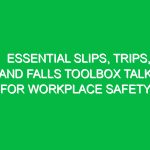Welcome to Our Toolbox Talk
Hello team! Today, we’re here for an essential toolbox talk focusing on a crucial aspect of our Workplace Safety: preventing falls. Whether you’re working on scaffolding, ladders, or even moving about on flat ground, understanding how to prevent falls is vital for your Safety and the Safety of your coworkers. Falls are one of the most common causes of workplace injuries, and they can be serious or even fatal. So let’s dive into the details of what we can do to minimize risks and create a safer work Environment.
Understanding Falls in the Workplace
Falls can occur in many different ways; they can happen when you’re on a ladder, navigating uneven surfaces, or even when you’re Working at Height. According to the Occupational Safety and Health Administration (OSHA), falls are the leading cause of death in the construction industry. But it’s not just construction workers who are at risk; employees in various sectors can experience falls while performing their daily tasks. Understanding the types of falls and how they occur is the first step in Prevention.
Types of Falls
- Falls from Heights: These can happen when working on ladders, scaffolds, roofs, or any elevated surface.
- Same-Level Falls: These occur when someone slips or trips on the same level, such as wet floors or uneven ground.
- Falls through Openings: These involve falling through holes or openings in floors, roofs, or other surfaces.
Why Fall Prevention Matters
Preventing falls is not just about adhering to Regulations; it’s about protecting yourself and your colleagues. When someone falls, the consequences can be dire, leading to serious injuries or even fatalities. Moreover, workplace incidents can create a ripple effect, impacting productivity, morale, and even the company’s reputation. By prioritizing fall prevention, we contribute to a culture of safety that Benefits everyone.
Key Statistics
Consider these statistics:
- In 2020, falls accounted for approximately 32% of all workplace fatalities.
- More than 200,000 workers were treated for fall-related injuries in emergency rooms across the country.
These numbers highlight the urgency of fall prevention measures. Awareness and proactive behaviors can save lives.
Identifying Potential Hazards
The next step in preventing falls is to identify potential Hazards in your work environment. Here are some common risks:
- Uneven Surfaces: Cracks, potholes, and other irregularities can lead to trips.
- Wet or Slippery Conditions: Spills, rain, or ice can make surfaces hazardous.
- Improper Use of Ladders: Using ladders incorrectly can increase the risk of falling.
- Inadequate Fall Protection Systems: Lack of guardrails or harnesses when working at height is a significant risk.
Best Practices for Fall Prevention
Now that we understand the risks, let’s talk about some actionable practices you can implement daily to help prevent falls.
1. Conduct Regular Inspections
Before starting your shift, take a moment to inspect your work environment. Check for any hazards like loose cables, debris, or wet floors. If you spot something unsafe, report it immediately to your supervisor.
2. Use Proper Equipment
Always use the right equipment for the job. If you need to work at height, ensure that you have a sturdy ladder or scaffold that has been inspected and is in good condition.
3. Wear Appropriate Footwear
Footwear plays a vital role in preventing slips and falls. Make sure you wear shoes with good traction and support. Avoid loose or overly worn shoes that can increase your risk of falling.
4. Maintain Clear Pathways
Keep walkways and work areas clear of clutter and obstacles. This includes tools, materials, and any other objects that could cause someone to trip.
5. Use Fall Protection Systems
When working at heights, always use fall protection systems, such as guardrails, safety nets, or personal fall arrest systems. Familiarize yourself with the correct use of these systems and ensure they are in place before starting any elevated work.
6. Communicate with Your Team
Effective communication is key in preventing falls. Always inform your coworkers if you are working in an area where a fall could occur. Use clear signals or verbal warnings to keep everyone informed.
Real-Life Examples
Let’s consider a few scenarios that illustrate the importance of fall prevention.
Scenario 1: Working on a Ladder
Imagine you’re tasked with painting a high wall. You grab a ladder but forget to check that it’s on stable ground. As you reach the top, the ladder tips, and you fall. This situation could have been easily avoided by ensuring the ladder was placed on a flat surface and secured properly.
Scenario 2: Slippery Floors
Now, think about a day when it rains heavily. The entrance to your workplace gets wet, and someone slips while entering, resulting in an injury. By placing mats at the entrance and ensuring they are cleaned regularly, this incident could have been prevented.
Regulations and Standards
It’s also essential to be aware of the regulations surrounding fall prevention. osha has set forth standards that require employers to provide a safe workplace, including proper fall protection systems where necessary. Familiarize yourself with these regulations, as they are designed not only to keep you safe but also to protect the company against legal issues. Each of us has a role in compliance, and reporting unsafe conditions is part of that responsibility.
Encouraging a Safety Culture
Creating a culture of safety goes beyond just following protocols. It involves everyone’s active participation, from management to front-line workers. As team members, you should feel empowered to voice concerns and suggest improvements regarding fall prevention. Regular toolbox talks like this one play a crucial role in fostering an open dialogue about safety and keeping fall prevention at the forefront of our daily operations.
Conclusion
In closing, preventing falls is a shared responsibility. By understanding the risks, implementing Best Practices, and staying aware of potential hazards, we can significantly reduce the chances of accidents in our workplace. Remember, a safe environment benefits everyone, leading to a more productive and positive work experience.
Thank you for your attention today and for your commitment to maintaining a safe working environment. Let’s continue to look out for one another and make safety a priority every day. Are there any questions or thoughts you’d like to share regarding fall prevention?


